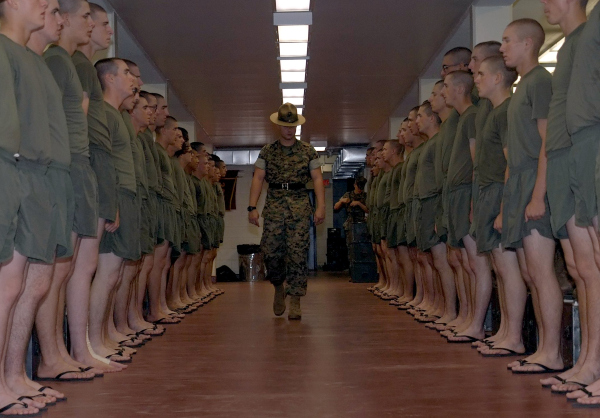The United States Marine Corps (USMC) is one of the smallest and most selective branch of the Armed Forces.
There are only 186,000 active-duty Marines compared to the U.S. Army which has over 1,000,000 and U.S. Navy with 337,000.
As a result, surviving Marine Corps basic training is your primary hurdle to getting recognized as an official Leatherneck.
Here is your ultimate survival guide to Marine Corps basic training.
Related Article: 13 Pros And Cons Of Joining The Marines
1. Marine Corps Basic Training Overview
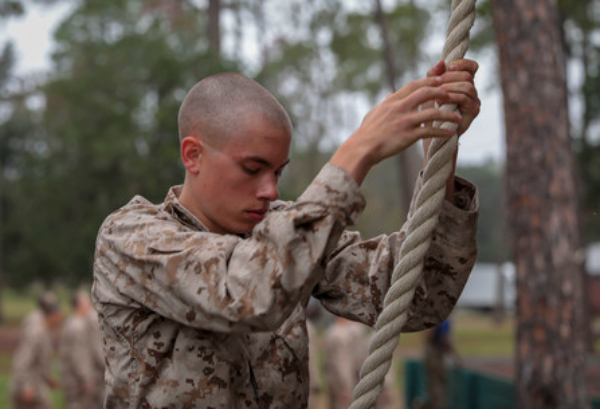
The United States Marines serves as the expeditionary and amphibious operations force for the military.
Marine Corps basic training takes place at one of two locations:
- Recruit Training Depot (Parris Island, South Carolina)
- Recruit Training Depot (San Deigo, California)
Where you get assigned for boot camp generally depends on where you live in the United States.
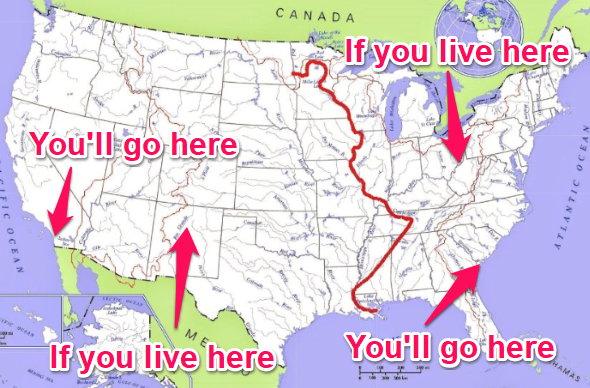
However, female recruits of the United States Marine Corps train at Parris Island regardless of where they live in the country.
Marine Corps basic training is considered the most challenging of any of the boot camps in the U.S. Armed Forces.
Recruits not only have to endure a longer training period (91 days), but also more physical and mental demands.
The objective of the USMC is to transform recruits into combat-ready warriors which is why the training is so rigorous.
The training schedule gets divided into three phases of lessons with 12 overall weeks at one of the Recruiting Depots.
USMC develops Marines by focusing on physical fitness, water survival, rifle marksmanship, close-order drill, and camaraderie in preparation for graduation.
The Marine Corps labels a new recruit “poolee” after he or she signs a contract with the USMC.
Poolees spend time at functions preparing for Marine boot camp by participating in marching and drill practice.
You can also practice the various physical fitness tests of the Marine Corps including the Initial Strength Test (IST).
Marine Corps Initial Strength Test (IST)
The best preparation you can take for joining the Marines is getting into shape.
Even if you think you are healthy and active, the Marine Corps is a whole other level when it comes to fitness.
In fact, the Marine Corps requires every recruit to pass the Initial Strength Test (IST) prior to boot camp.
Marine IST is a shorter version of the Physical Fitness Test (PFT) that you’ll need to complete during basic training.
The Marines tests you for pull-ups, sit-ups, push press, and 1.5-mile run for the IST.
You need to meet the minimum standards to continue your training with the USMC:
| Activity | Men | Women |
|---|---|---|
| Pull-Ups | 2 | 2 |
| Sit-Ups (2 Minutes) | 44 | 44 |
| Ammo Can Lifts | 45 | N/A |
| 1.5 Mile Run | 13:30 | 15:00 |
Keep in mind that the above figures are only the minimum requirements and recruits should strive to achieve higher numbers in the four events.
Prepare for Marine Corps basic training by running several miles each day, and practicing sit-ups and pull-ups.
It also helps to learn how to swim (if you don’t already know).
Additionally, the Marines begins with drill almost immediately.
Thus, spending some time studying basic drill and ceremony goes a long way in preparation for USMC basic training.
Lastly, familiarize yourself with Marine Corps military ranks and the 11 General Orders.
2. Marine Corps Basic Training Phases Explained
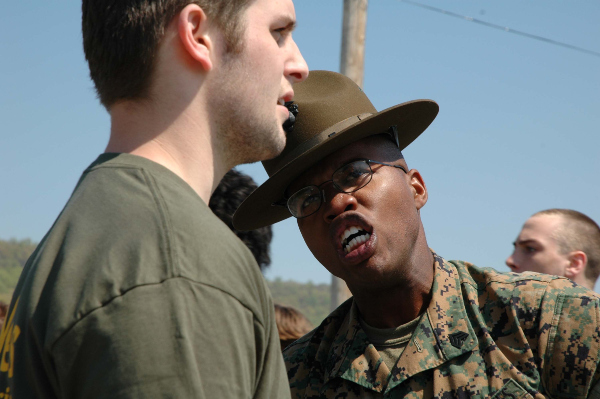
Marine Corps basic training takes a little over 12 weeks to complete.
It’s among the most grueling things you’ll do in your lifetime so make sure you are prepared!
Your first few days at boot camp involve a lot of paperwork, medical exams, and receiving uniforms and gear at Recruit Receiving.
While the first few days of Marine Corps boot camp is not too thrilling expect to get off the bus with a Marine Corps Drill Instructor (DI) already in your face and ears.
The Marine Corps assigns three or more DIs to each platoon.
A senior Drill Instruction delivers most of the orders while the second DI singles out recruits that fail basic requests and the third DI focuses on “quarter-decking”, or physical discipline.
Here is what you can expect during the 4 phases of Marine Corps basic training which get divided into three-week segments.
Phase I (Receiving Week – Week 4)
Phase I technically involves four weeks of training when you account for Recruit Receiving.
During Recruit Receiving you’ll receive medical and dental exams, uniforms, hygiene products, uniforms and gear, as well as a new haircut.
You also need to pass the Initial Strength Test (IST)
Phase I is extremely challenging as new recruits get accustomed to the rigorous and demanding habits of USMC boot camp.
Along with an initial strength test, new recruits also participate in beginning swimming drills, close-order drill marching, and pugil stick fighting.
Classroom learning begins with a proud history of the Marine Corps, along with its customs, core values, rank structure, code of conduct, and basic first aid.
The Marines introduces recruits to “forming” which includes the process of total immersion during Phase I.
Forming introduces recruits to their drill instructors as well as strict and confrontation lessons on learning how to march, wear your uniform, and secure weapons.
During the end of Phase I (week four), recruits learn how to leap into deep water, tread water, and use gear to stay afloat.
When you get “quarter-decked” expect discipline like doing push-ups, running in place, side lunges, leg lifts, or mountain climbing.
Related Article – Is Navy Boot Camp Hard?
Phase II (Weeks 5 – 7)
The first phase of boot camp is related to Basic Learning of the body and mind.
Meanwhile, the second phase of the Marine Corps basic training revolves around rifle exercises and marksmanship.
However, it’s still far from gravy experiencing weeks 5 through 7 of Marine Corps boot camp.
The Marine Corps enhances physical fitness demands where you now need to run three miles within 30 minutes (with a goal of finishing the run in under 18 minutes).
Grass Week introduces prospective Marines to rifle instruction.
The Marine Corps maintains the mentality that all recruits (regardless of MOS) need to become an effective marksman.
Therefore, every recruit must qualify for shooting standards using an M-16 rifle.
Grass Week (week six) teaches recruits proper firing positions and you spend hours in fields sighting on the field targets.
During week seven you start firing live rounds from different distances and firing positions (prone, kneeling, sitting, standing, etc.).
The Marine Corps has three levels of marksmanship: Marksman, Sharpshooter, and Expert.
Recruits must achieve a minimum shooting score of 190 to 250 points with the M-16 A2 service rifle to continue through basic training.
Additional responsibilities during Phase II of Marine Corps basic training includes doing chores around the Recruiting Depot during the fifth week.
Related Article: 10 Best Marine Corps Jobs For Civilian Life
Phase III (Weeks 8 – 10)
Phase III of Marine Corps basic training involves a lot of field exercises.
The third phase of training is among the most challenging physically and mentally in case you weren’t already drained during the first two phases.
Highlights of weeks 8-10 of USMC training includes a drill marching competition, knowledge test, and a final PFT test.
Recruits need to complete Basic Warrior Training during week 8 of boot camp.
Prospective Marines receive the basic skills of survival combat like advanced marksmanship, land navigation, and enemy maneuvering.
During the final two weeks of Phase III, recruits need to pass various academic tests to prove their knowledge.
Secondly, recruits need to complete the Crucible (week 10).
The Crucible is a legendary 54-hour field event that tests your knowledge, skills, and values you have received throughout basic training.
The Crucible features several obstacle courses, outdoor survival drills, day and night combat movement courses, and team exercises.
It culminates with a 10-mile hike into the wilderness around one of the two training depots.
Once you complete the Crucible, participants receive their Eagle, Globe, and Anchors which symbolizes your transition from recruit to official Marine.
Phase IV (Weeks 11 – 12)
Completing the Crucible is a major final step in your transition from a recruit to an official Marine.
However, make sure you don’t get complacent during your remaining days at Parris Island or San Diego.
You will receive inspections by a battalion commanding officer to make sure you are fit for service.
The last thing you want is to get in trouble and risk violating policy just because you think you’ve made it.
There are also several administrative tasks you need to complete before the graduation ceremony.
The Marine Corps graduation ceremony for basic training is exciting to celebrate your progress and becoming part of an elite military branch.
You should invite family and friends to the graduation ceremony.
Newly appointed Marines receive 10 days of leave after graduation before you must report to Camp Lejeune (North Carolina).
From there you receive additional combat training before getting a transfer to focus on specialized training for your Military Occupational Specialty (MOS).
3. What’s A Typical Day Like?
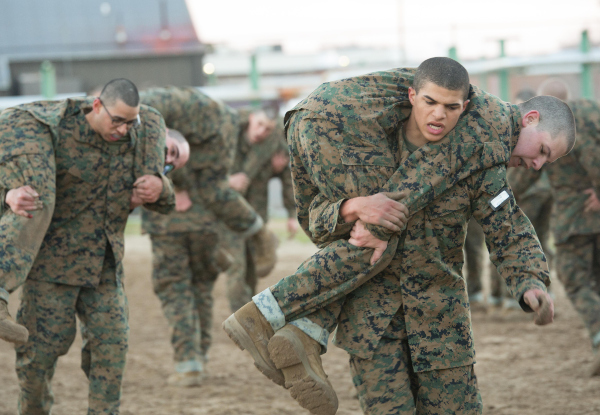
Marine Corps basic training is considered the most intense of any military branch.
Recruits drop out between 11-14% from Marine boot camp.
Sometimes not being able to serve the U.S. Marines is outside your control (i.e. a chronic disease).
In other cases, you can improve your odds of joining the Marines by preparing physically and mentally for boot camp.
Here is a good idea of what you can expect to participate on a daily basis at boot camp:
- First Call: Expect an early morning wake up where you have a short amount of time to shave and shower.
- Physical Training: Normally consists of six limbering exercises along with the “daily dozen”.
- Morning Chow: The food isn’t spectacular but you’ll need it for energy.
- Morning Training: The type of training depends on the phase.
- Afternoon Chow: You’ll be hungry, trust us.
- Afternoon Training: Once again the type of training depends on the phase.
- Evening Chow: Your final meal of the day so make it count.
- Drill Sergeant: The DI has control over how to use this time each day.
- Personal Time: You’ll have a little free time each night, but make sure you stay out of trouble.
- Lights Out: The Marine Corps enforces curfew just like any other military branch.
The Marine Corps utilizes a progressive physical training program.
What that means is you’ll build up your strength and endurance with more challenging fitness exercises as the weeks of boot camp continue.
Free Time
You will get eight hours of sleep and should value your free time to refuel for the next day.
Free time allows you an opportunity to read, write letters to family or friends, and watch instructional television.
You are entitled to one hour of uninterrupted free time each evening (Monday through Saturday) along with four hours on Sundays and holidays.
Company commanders have the option of enacting two additional hours of free time on Saturdays, though it is not guaranteed.
Free time can also get suspended because of punishment.
4. Basic Training Packing List
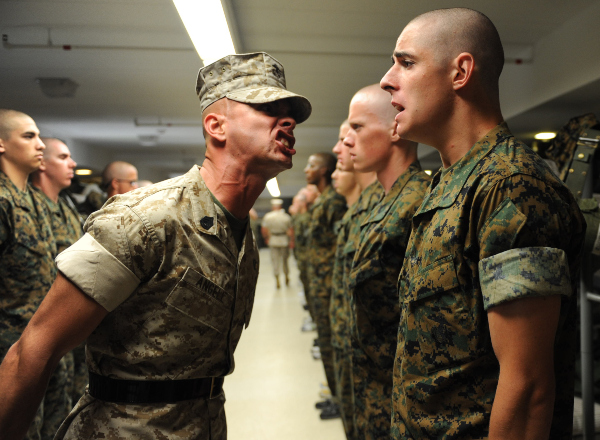
While it might make sense to pack everything you would normally need during a 12-week stay, the same is not true of USMC boot camp.
The Marine Corps will provide all the essentials you need for basic training.
Consequently, only bring the following:
- Driver’s License
- Social Security Card
- Banking Information (for Direct Deposit)
- Copy of High School Diploma
- Running Shoes
- Family Photos
- Address Book
- Stamps
- Cash
Everything else the Marine Corps will issue to you upon receiving.
Make sure you avoid bringing the following items:
- Over the Counter Medication
- Cellphones
- Electronics
- Jewelry
- Razor Blades
- Hygiene Products
- Female Products
The Marine Corps evaluates new recruits that take prescription medication.
If a military doctor determines the prescription is necessary you will get a reissue of the same medication during boot camp.
Frequently Asked Questions (FAQ)
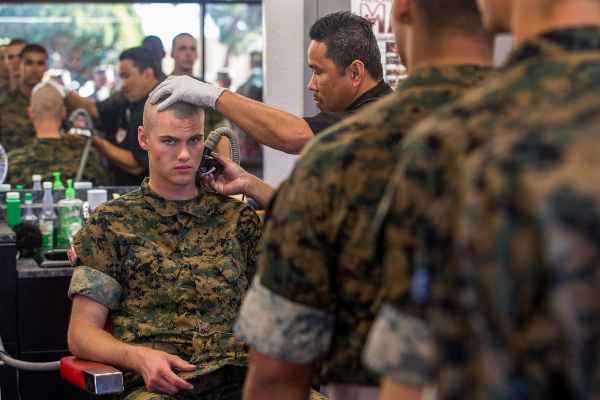
Here are some frequently asked questions about the Marine Corps basic training…
Related Article: 7 Benefits Of Joining The Marine Corps
5. How hard is the Marine Corps basic training?
Most experts believe that Marine Corps basic training is the hardest of all the branches.
The opinions not only come from experts but those that have served in the military.
For starters, USMC boot camp is longer (12 weeks) compared to the U.S. Navy (7 weeks) and Army (10 weeks).
The Marine Corps expects all recruits (regardless of intended MOS) to participate in close combat training exercises.
You need to become a Marksman with an M-16 rifle.
Marines also need to be advanced swimmers and other specialty skills.
Surviving the Crucible is a three-day event that challenges you in every way imaginable.
6. How should I prepare for basic training?
First, start exercising every day to prepare for boot camp.
It’s important to run several miles in the Marines as well as have strength training and the ability to swim.
Daily PT in the Marine Corps includes six limbering exercises and the “daily dozen”.
Practice bends and thrusts, rowing, side benders, side-startle hops, leg lifts, toe touches, trunk twists, push-ups, bend and reach, body twists, squat benders, and mountain climbing.
Secondly, familiarize yourself with the culture of the Marine Corps and whether you believe you are a good fit for military service.
The military isn’t for everyone and you need to pass medical and dental examinations before getting cleared for service.
7. What percentage of Marines make it through boot camp?
The dropout rate for USMC basic training is between 11-14% each year.
The attrition rate is comparable to the U.S. Army and Navy.
However, the Marine Corps accepts a lot fewer active-duty and reserves compared to the other military branches.
It makes it the most selective of the eight uniformed services of the U.S. military.
8. Will I get paid during basic?
Yes, recruits start earning pay the first day they arrive at boot camp.
It’s important to bring your bank information to Recruit Receiving so you can sign-up for Direct Deposit.
However, during basic training, you’ll need to create a new account on base to receive your compensation during boot camp.
After graduation, you can start earning funds to your personal bank account.
Recruits are paid bi-monthly like other members of the Armed Forces.
9. What happens after basic?
Even though you can (and should) take a brief moment to celebrate your achievements at boot camp, you are not done with basic training.
The United States Marine Corps requires newly official members of the branch to participate in the School of Infantry (SOI).
Like boot camp, there are two locations for Marine SOI:
- SOI East: Camp Geiger, North Carolina
- SOI West: Camp San Onofre, California
You’ll begin SOI training after 10 days of leave following the graduation ceremony of basic training.
10. What types of jobs would I have?
There are currently over 120 jobs, or Military Occupational Specialties (MOS) you may serve in the USMC.
Marine MOS involves everything from combat roles like infantry to communications and food service.
Browse the complete list of Marine Corps MOS here.
11. Where will I be based once all training is complete?
There are Marine bases throughout the United States and abroad.
The Marine Corps currently has domestic bases in 9 states.
Marines may also receive assignment on Navy ships or other locations.
Learn more about the top Marine Corps bases in the United States.
Conclusion
Marine Corps basic training is arguably the toughest of all the military branches.
Prepare for the four phases of boot camp by getting into shape and following our informative guide.
You can also ask a local Marine recruiter for more information or questions.
See Also
How To Prepare For Marine Boot Camp
What To Bring To Marine Boot Camp
Marine Corps Boot Camp Graduation
Marine Infantry Training Battalion (ITB)
- Marine Corps Boot Camp Schedule - June 20, 2024
- What To Bring To Marine Boot Camp - June 20, 2024
- Marine Corps Promotion Timeline for Enlisted & Officers - June 19, 2024
Originally posted on March 12, 2020 @ 6:52 pm
Affiliate Disclosure: This post may contain affiliate links. If you click and purchase, I may receive a small commission at no extra cost to you. I only recommend products I have personally vetted. Learn more.
